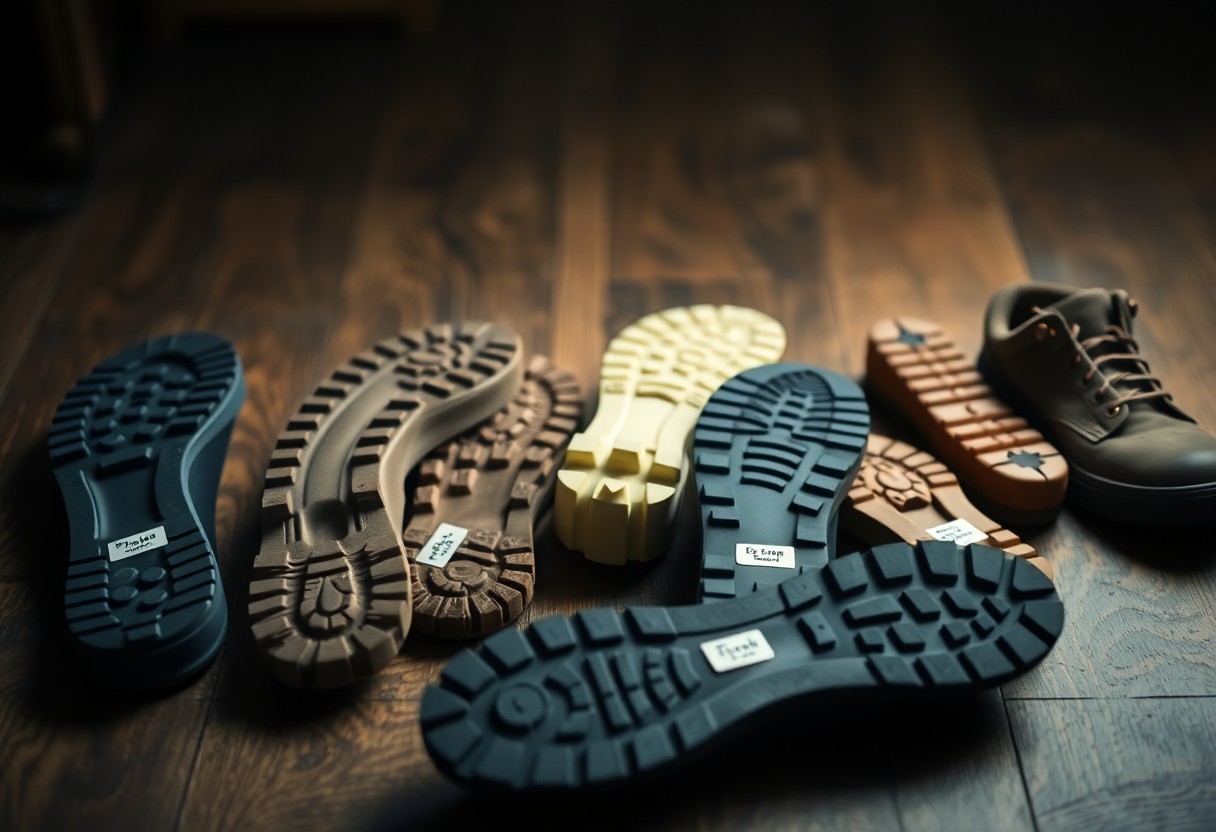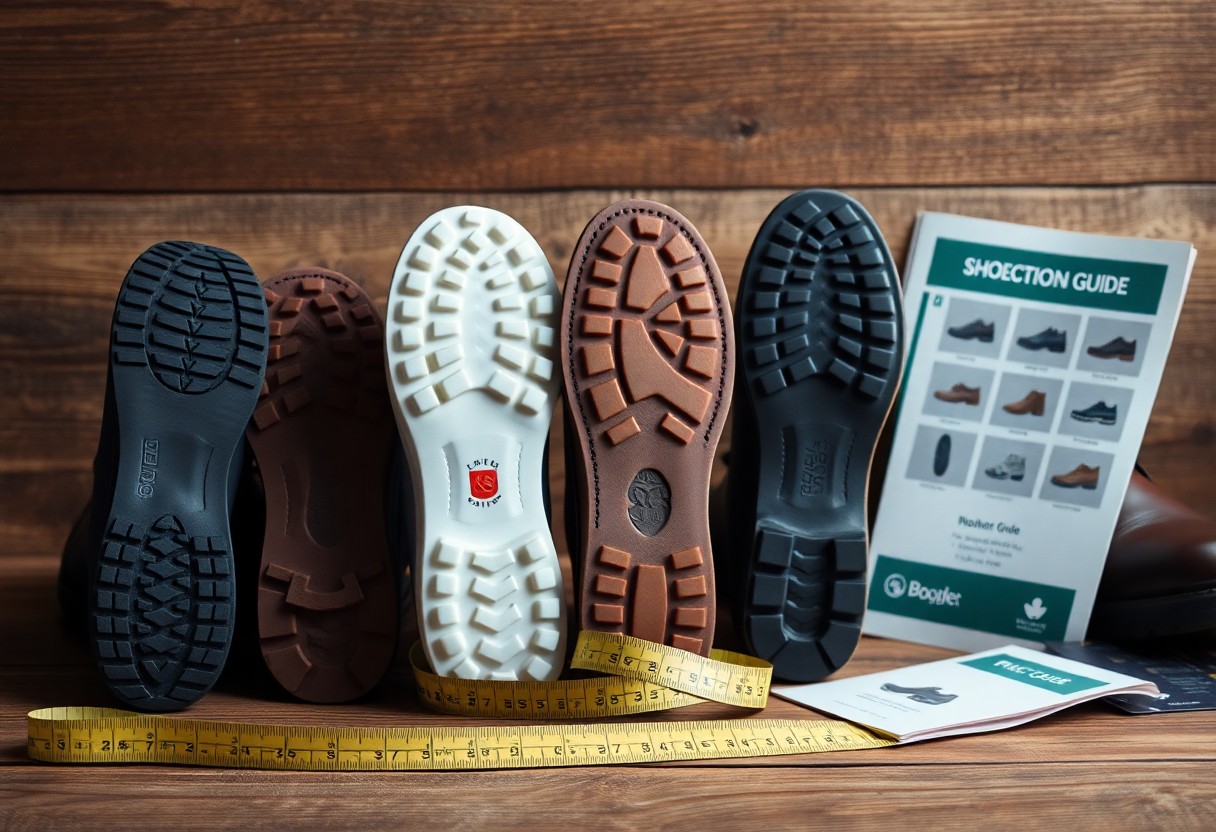
When choosing the right footwear, many people tend to overlook the pivotal role of shoe soles. This fundamental element plays a crucial part in determining your overall comfort, safety, and performance while wearing shoes. The type of sole you select could be the deciding factor in whether you achieve stable footing on slick surfaces, or face the risk of unwanted slips. Moreover, the right sole contributes to long-lasting comfort and durability, preventing premature wear and tear. With options ranging from classic leather soles to advanced rubber compounds, each sole type offers distinct advantages tailored for specific activities. This detailed guide is designed to clarify the key features of various sole types and help you choose the ideal option for your specific lifestyle needs, whether for work, leisure, or outdoor excursions.

Unlock the Advantages of Leather Soles for Optimal Footwear Performance
The choice of leather soles can profoundly influence the character, comfort, and performance of your shoes. Renowned for their superior breathability and natural comfort, leather soles conform to the shape of your foot over time, resulting in a uniquely personalized fit. Although they may require more maintenance compared to synthetic options, leather soles provide an exceptional ground feel, making them an ideal choice for formal settings where a polished appearance is essential. By understanding the specific benefits offered by leather soles, you can make a well-informed decision that enhances your overall wardrobe while elevating your walking experience.
Elevate Your Style with Single Leather Soles for Dress Shoes
Soles made from a single layer of leather represent the quintessential choice for sophisticated dress shoes. These soles are crafted to deliver remarkable flexibility and a refined appearance, perfect for enhancing your style at formal events. While they provide greater breathability in comparison to rubber alternatives, it is vital to exercise caution in wet conditions to avoid potential damage. By opting for single leather soles, you not only embrace a classic aesthetic but also enjoy the comfort that comes from high-quality craftsmanship.
Benefit from Increased Durability with Double Leather Soles
Double leather soles, constructed with two layers of leather, offer you superior durability and enhanced insulation against cold surfaces. Although they may feel slightly stiffer compared to single leather soles, they provide extra protection for your feet across a variety of conditions. This design ensures that double leather soles can outlast their single-layer counterparts, making them a wise investment for regular use. They are particularly suitable for individuals with a heavier build or for those who frequently partake in outdoor activities. However, be prepared for a lengthier break-in period to achieve maximum comfort.
By selecting double leather soles, you’re choosing a footwear solution that merges longevity with performance, ensuring your shoes can withstand the rigors of daily life while maintaining their stylish appearance.
Optimize Footwear Functionality with HAF (Half and Full) Soles
HAF soles combine the best features of both single and double leather soles by integrating single leather in the waist and heel with double leather in the forepart. This innovative design provides you with exceptional durability in high-wear areas while maintaining a sleek and elegant look. The unique construction of HAF soles promotes balanced weight distribution and increased comfort, effectively safeguarding high-wear zones without compromising the shoe’s sophisticated profile. It’s essential, however, to ensure that your cobbler incorporates the appropriate heel compensation to achieve optimal balance tailored to your feet.
Explore the Flexibility of Natural and Mixed Soles for Everyday Footwear
Natural and mixed soles offer a versatile blend of comfort and durability ideal for day-to-day use. These soles often combine organic materials such as cork, natural rubber, or leather with synthetic components to create high-performing footwear options. When considering which natural or mixed sole is right for you, think about your specific needs in terms of grip, weight, and resistance to various weather conditions. Being aware of these factors will empower you to make an informed choice that aligns perfectly with your active lifestyle.
Discover Lightweight Comfort with Nitrile Cork Soles
Beyond conventional rubber options, nitrile cork soles introduce a lightweight alternative that boasts impressive durability. By blending cork with nitrile rubber, these soles are 30% lighter than traditional rubber soles, making them a favored choice for American shoes and boots where comfort is a priority. Available in both smooth and treaded designs, nitrile cork soles cater to those who seek lightweight footwear without sacrificing performance. Opting for these soles allows you to navigate your daily activities with effortless style and comfort.
Embrace Casual Comfort with Natural Crepe Soles
Natural crepe soles, made from pure rubber, provide outstanding comfort thanks to their soft, cushioning properties. Best suited for casual footwear, these soles offer varying degrees of grip depending on the surfaces you encounter. While crepe soles deliver exceptional comfort for everyday wear, they do come with certain limitations. Their soft material results in a wear rate that is approximately 40% faster than standard rubber soles, and their grip may falter on wet surfaces. Consequently, while many appreciate the comfort that crepe soles offer, it’s wise to consider the likelihood of needing more frequent replacements.

Discover the Key Benefits of Rubber Soles for All-Weather Performance
Rubber soles are particularly notable for their excellent grip and water resistance, which surpasses that of leather soles in most cases. These soles prove especially advantageous in wet conditions, making them a preferred choice for daily wear across diverse weather scenarios. Rubber soles not only offer remarkable durability but also require less maintenance than leather options. However, it’s worth noting that they may feel warmer on your feet during the hot summer months. The practical advantages of rubber soles make them a smart choice for anyone seeking consistent performance and comfort in their footwear.
Achieve a Perfect Blend with Rubber Topy Soles
Rubber Topy soles serve as a superb compromise between leather and rubber soles, offering you the best of both worlds. They provide the classic look of leather soles while enhancing grip and durability. A thin layer of rubber is bonded onto a slightly sanded leather sole, effectively extending the lifespan of your footwear by up to 50%. This combination allows you to enjoy the aesthetic appeal of leather without sacrificing functionality, making Rubber Topy soles a worthwhile investment for your shoe collection.
Experience the Ideal Fusion of Style and Functionality with City Rubber Soles
City rubber soles allow you to achieve a sleek, dress shoe appearance without compromising on practicality. These thin rubber soles closely mimic traditional leather soles while providing enhanced traction and waterproofing. Growing in popularity for modern dress shoes, city rubber soles not only elevate the visual appeal of your footwear but also enhance durability, requiring less frequent resoling. Perfect for urban environments, these soles can easily withstand the rigors of concrete sidewalks and the occasional rain, ensuring you look stylish while remaining comfortable.
Enhance Longevity with Dainite and Studded Soles
Among rubber options, Dainite and studded soles provide remarkable durability and grip. Their unique studded pattern guarantees reliable traction while maintaining a formal appearance, making them particularly suitable for business casual shoes and dress boots. While Dainite soles are highly resistant to wear, it’s important to note that they can become slippery in freezing conditions. User experiences may differ, as some may find them firmer than other sole types. Nevertheless, for everyday use in moderate conditions, these soles generally outlast traditional leather soles by 2-3 times, making them an excellent choice for those prioritizing durability.
Essential Performance Features of Shoe Soles That Matter
Your choice of shoe sole can dramatically affect your daily comfort, safety, and overall performance. Different types of soles provide distinct levels of grip, shock absorption, and flexibility, each serving specific purposes from preventing slips on wet surfaces to alleviating foot fatigue during extended periods of walking. By understanding these performance attributes, you will be better equipped to select the ideal sole type that meets your unique needs, ultimately enhancing your overall footwear experience.
Assess Durability Factors in Different Sole Materials
The longevity of various sole materials can greatly differ in terms of wear resistance. Generally, rubber compounds outlast leather soles by three to four times, while nitrile cork serves as a middle ground. Key factors such as material density and tread pattern significantly impact how long your soles will last. Being aware of these durability elements empowers you to make cost-effective footwear choices tailored to your individual lifestyle.
Understand Weather Resistance for Optimal Footwear Performance
Factors like water resistance, temperature tolerance, and traction are critical in assessing how your soles perform across various environmental conditions. Typically, rubber soles provide superior grip in wet conditions, while leather soles excel in dry environments. Remember that temperature fluctuations can greatly impact sole performance; some rubber compounds might become dangerously hard in freezing temperatures, while others retain their flexibility. Your local climate should inform your selection: city rubber soles are best for mild wet conditions, whereas specialized winter soles offer enhanced safety in icy or snowy environments.

Your Complete Guide to Choosing the Right Shoe Sole
It’s crucial to acknowledge that not all shoe soles are created equal; your choice should align with your unique needs and preferences. Selecting the right sole type can significantly affect your comfort, safety, and the longevity of your entire footwear collection. This guide aims to assist you in identifying the most suitable sole type based on your lifestyle, activities, and environmental conditions.
Reflect on Your Daily Activities When Selecting a Sole
When choosing a sole, it’s important to consider key factors such as your daily activities and the walking surfaces you frequently encounter. For office settings, thin leather or city rubber soles are appropriate, while industrial environments benefit from thick rubber or studded soles that offer enhanced protection. If you’re active outdoors, focus on grip requirements and durability needs. Understanding your primary usage will help you narrow down the most suitable options available.
Consider Climate Factors for Optimal Sole Performance
In addition to weather conditions, temperature variations can affect the performance of shoe soles. Here are some critical considerations:
- Wet conditions – rubber soles offer superior grip
- Cold weather – thicker soles provide better insulation
- Hot climates – breathable leather soles are optimal
- Variable weather – hybrid soles offer versatility
Understanding your local climate patterns is fundamental to selecting the most appropriate sole type for your footwear.
Moreover, it’s vital to consider how different sole materials perform in various weather conditions:
- Leather soles require special care in wet conditions
- Rubber soles can become very hard below 0°C
- Nitrile cork provides a good balance in moderate conditions
- City rubber soles deliver year-round versatility
Being cognizant of these characteristics ensures your footwear will perform optimally throughout the seasons.
Essential Maintenance and Care for Long-Lasting Soles
To maximize the lifespan and performance of your shoe and boot soles, regular maintenance is essential. The durability of your soles greatly relies on proper care, which encompasses cleaning, drying, and protective treatments. Each sole material has specific maintenance requirements; for instance, leather soles necessitate waterproofing, while rubber soles benefit from routine debris removal.
Establish Efficient Cleaning Routines for Your Footwear
A well-maintained sole starts with a consistent cleaning routine. To preserve the integrity of your footwear, you should:
- Use a soft brush to gently remove dirt and debris
- Clean with mild soap and water
- Utilize specialized cleaners formulated for specific materials
- Ensure thorough drying after cleaning to prevent mold and damage
Identifying the appropriate cleaning methods for your specific sole type will aid in preventing damage and prolonging the life of your footwear.
Implement Effective Preservation Strategies for Extended Sole Life
To extend the longevity of your soles, consider these practical tips:
- Rotate your footwear daily to allow for proper airing and reduce wear
- Use shoe trees during storage to maintain shape and structure
- Apply protective sprays as needed for added moisture and stain resistance
- Regularly inspect for wear patterns to catch signs of deterioration early
By being proactive and recognizing early signs of wear, you can take measures to prevent irreversible damage to your footwear.
It’s important to note that preservation methods can vary widely depending on the sole type:
- Leather soles require waterproofing every 3-4 months for optimal protection
- Rubber soles should be regularly checked for cracks and wear
- Cork soles need protection from excessive moisture
- Crepe soles should be kept away from extreme heat sources
Understanding the specific needs of your sole type ensures effective maintenance and longevity for your footwear investment.
Empower Your Footwear Choices with Informed Decisions
Your selection of shoe sole plays a pivotal role in determining your comfort, safety, and overall performance. Aligning your sole type with your specific requirements is essential—whether that entails choosing leather soles for formal occasions or rubber soles for unpredictable weather. Considerations such as your lifestyle, preferred walking surfaces, and local climate should guide your ultimate choice. For example, a single leather sole may offer elegance for dress shoes, while Dainite or city rubber soles enhance grip and durability. By gaining a comprehensive understanding of various sole types and their unique benefits, you can make informed decisions that fulfill your daily needs and personal preferences.
Frequently Asked Questions About Shoe Soles
Q: What are the main differences between leather and rubber soles?
A: Leather soles are celebrated for their superior breathability and their ability to conform to your feet over time, making them ideal for dress shoes. They excel in dry conditions but necessitate careful handling in wet weather. On the other hand, rubber soles provide better water resistance and grip, generally last longer, and are suitable for a wide range of weather conditions. Additionally, rubber soles are typically more affordable and less maintenance-intensive compared to leather soles.
Q: How can I choose the right sole type to meet my daily needs?
A: To select the appropriate sole type, consider the environments and activities you engage in most frequently. For formal office settings, leather soles are a solid choice, while rubber soles are better suited for outdoor activities and wet conditions. For versatile use across varying weather scenarios, studded soles like Dainite are fantastic options. For casual outings, crepe soles provide excellent comfort, albeit with a shorter lifespan. Align your sole type with your predominant activities and environmental conditions to ensure optimal performance.
Q: What advantages do double soles have compared to single soles?
A: Single soles offer greater flexibility and a sleeker profile, making them perfect for dress shoes. In contrast, double soles are engineered for superior durability and enhanced insulation against cold and wet conditions. They work well for casual shoes and boots but typically require a longer break-in period. While double soles may add some weight to the shoe, they also provide additional protection for challenging terrains.
The Article Guide to shoe and boot sole types features benefits and how to choose the right one appeared first on My Shoes Finder
The Article Shoe and Boot Sole Types: Features, Benefits, and Selection Tips Was Found On https://limitsofstrategy.com

